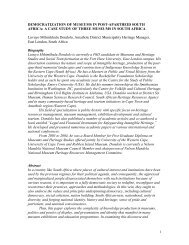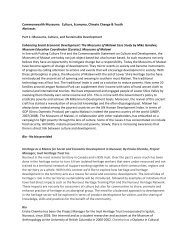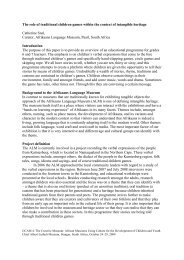You also want an ePaper? Increase the reach of your titles
YUMPU automatically turns print PDFs into web optimized ePapers that Google loves.
Development of InfrastructureInfrastructure development was the largest component of the project. It included a museumand community centre, boats, piers, docks, signage as well as pathways, railings, toilet andshower facilitiesThe Museum and Community CentreJack Obonyo had initially constructed a small iron sheet-roofed hut with mud walls – this isthe structure that housed the ACPM since its inception. Scanty artefacts lay strewn on thefloor of the ‘museum’ while a majority of the artefacts collected had long been returned totheir owners owing to concerns of lack of proper display or storage facilities. If this museumwas to attract more artefacts and visitors, then the structure needed major improvements.Initially envisaged was a fairly small and basic structure that would serve as a museum andperhaps house a small office <strong>for</strong> the curator. However, as the thought process developed itbecame clear that there was a need to have space <strong>for</strong> community interaction in addition tothe museum. This space turned out to be a community centre complete with a restaurantand seminar facilities, which now acts as the sustainability component of the museum dueto its potential to generate revenue.28The construction process began with numerous discussions with the architect – Philip Okelloof Urban Designs Associates – who went back and <strong>for</strong>th with various designs until the finaldesign was approved by the community and the TARA Board. The project envisaged theuse of local materials to the greatest extent possible <strong>for</strong> a number of reasons: to embraceeco-friendly standards, to engage local people in the supply of materials, to reflect culturaltraditions in the area, and to promote traditional knowledge in building construction.In January 2008, at the height of Kenya’s post-election violence, the Abasuba community,TARA’s staff and Board members and the community defied all odds to conduct agroundbreaking ceremony of the museum and community centre. It was then that we fullyrealised that the Abasuba people were unique and truly peaceful. TARA staff from differentcommunities, including areas that were considered ‘enemies’ at the time, were warmlywelcomed to the island without any hint of hostility or mistrust. Mfangano justly lives up toits name as an island of peace.








